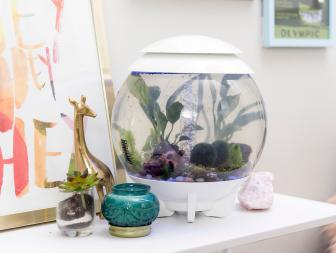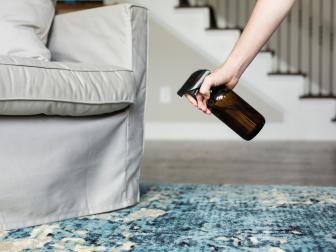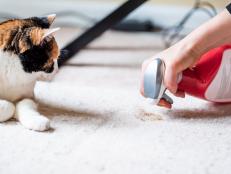Here's How to Clean an Aquarium the Right Way
Are you a new fish parent? Then, you’re probably wondering how to clean an aquarium. Like most things, there’s a right way and a wrong way. We’ll share both (and the wrong way might surprise you).
Whether you have a fresh or saltwater tank, cleaning your aquarium is the most important part of owning fish. It balances the tank’s ecosystem, which helps your fish — from bettas to tetras — stay healthy and happy. It keeps the water clear and the glass sparkling so you can get all the benefits of tank-gazing, like increased relaxation and improved wellbeing.

GettyImages/vgajic
How Not to Clean an Aquarium
When you think of cleaning an aquarium, you might picture it like cleaning a bathroom: Empty the aquarium; give everything a good, disinfecting scrub; and put it all back. But if you do that to a fish tank, you’ll kill the animals.
That’s because, inside your tank, there’s a delicate ecosystem at work, including beneficial colonies of bacteria. These colonies eat the animals’ waste and naturally filter the water. Some aquarium animals, like coral, also feed on the bacteria, bad and good. So, cleaning an aquarium is really about maintaining the ecosystem, rather than disinfecting.
1. Clean the Glass

Shutterstock/Sergiy Akhundov
The first step in cleaning an aquarium is to gently scrub the inside glass. Use an algae scrubber rather than a kitchen scrubber. Even though they look similar, the kitchen scrubber can contain soap or chemicals, which will upset your tank’s balance. Instead, buy the ones at a pet shop that are made for aquariums.
James Kennedy of the Coral Connection in Sarasota, Florida, says most people clean their inside glass weekly or monthly. But he recommends doing it daily. (He cleans the glass in his tank every morning while he’s having his coffee.)
Why? First, because you want the glass to be clean so you can enjoy your fish. Second, waiting too long between cleanings makes the job harder. And third, releasing too much waste into the water at once can hurt the animals.
2. Clean the Tank Decor
Once the glass is clean, take out any decor (plastic decorations, artificial plants, large rocks, etc.) and scrub it with the algae scraper and plain water. Don’t use soap or harsh chemicals, which can disturb the tank’s good bacteria. Even after you rinse the decor, traces of these chemicals can stay on the decorations and pollute the water.
If you run into some hard-to-scrub algae, prepare a 10 percent bleach solution and soak the decorations in it for 15 minutes. Scrub again, rinse well and let air dry.
After your decor is clean (whether or not you bleached it), rinse it with dechlorinator. Follow the instructions carefully on the dechlorinator so you don’t add too much or too little.
3. Vacuum the Gravel

GettyImages/vgajic
While the decorations are out, use a tank siphon to vacuum the gravel, draining the water into your bucket. (The siphon will stir up the water enough to remove debris, but it’s not strong enough to suck up the gravel.) Clean the entire surface of the gravel, all the way down to the tank bottom.
Suction off 10-20 percent of the water while you’re cleaning the gravel (for example, 10-20 gallons of water per 100-gallon tank). Change the water you siphoned off with dechlorinated water. The new water should be the same temperature as the water in the tank. That’s because too much of a temperature change can shock the fish and disrupt the bacteria.
Kennedy recommends changing smaller amounts of water more frequently, because it’s less stressful on the animals. For example, replace 10 percent of the water every week, or 20 percent every two weeks. If you clean your tank monthly, don’t change more than 30 percent of the water, Kennedy says.
4. Clean the Outside of the Tank
Next, clean the light, hood, top of the tank and outside glass. Use an aquarium-safe cleaner, like vinegar, rather than glass cleaners or anything with ammonia, which is toxic to fish. (Lime cleaners are even more toxic.) Always rinse the surfaces with a clean, damp cloth.
Return your decorations to the tank and your work is done. It’s time to enjoy relaxing with your fish.
5. Clean the Filter … Later
There are lots of filters for fish tanks, including hang-on filters and canisters. They vary based on the type of fish you keep, size of the tank, noise level and type of water (salt vs. fresh). However, they all have one thing in common: They shouldn’t be cleaned the same day you clean the tank.
That’s because cleaning the tank disturbs the beneficial bacteria. Many of these bacteria live in the filter media, and if you strip them out when you clean the tank, you’ll run the risk of crashing the ecosystem.
Also, Kennedy says to replace the filter media every two to three weeks to keep the filter running optimally. He recommends cleaning the tubing and assembly with a filter brush. If you have a mechanical filter (ceramic rings, sponges, etc.), instead of brushing it, rinse it gently to remove debris.
Cleaning your aquarium regularly protects its delicate ecosystem. It also keeps your fish happy and healthy, so you can enjoy all the benefits of owning them for years to come.
More Tips for Pet Owners
Best Plants for a Betta Fish Tank
We share five low-maintenance plants that will help keep your betta fish happy and thriving.
13 Cleaning Tips for Pet Parents 13 Photos
Spend more time cuddling with your furry family members and less time cleaning up after them with these smart tips.
13 Pet Products You Didn't Know You Needed
Take some of the work out of caring for your pet with these clever gadgets and gear.
















































